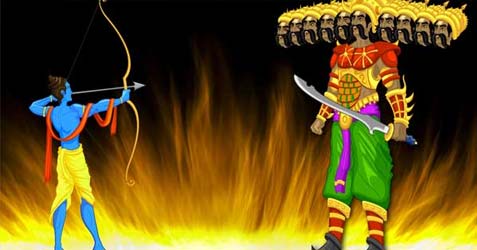


There are many stories related to this festival. Some of them are as follows :
Dussehra is also known as Vijaya Dashami, because of the victory of Rama over Ravana. On this day in Satya Yug, Ram (the eighth incarnation of Lord Vishnu), killed the great demon and king of Lanka, Ravana.
Dussehra marks the triumph of Lord Rama's victory.
After vanquishing him, Rama with Sita and Laxman returned victorious to his kingdom of Ayodhya on Diwali Day.
On Dussehra, the tenth day the celebration of good over evil is marked by burning the effigy of Ravana along with his son Meghanad and brother Kumbhkarana. The statue of the 10 headed demon Ravana is made of wood, hay etc with fireworks inside.
Puranas also opined that in this day warrior Goddess Durga defeated and killed the buffalo demon Mahishasura Vijayadashami is also celebrated as the day of victory to rejoice about Durga's triumph over the demons led by Mahishasura. It is essentially a festival in honor of Durga. The Divine Mother fought with him for nine nights, and killed him on the evening of the tenth day, known as the Vijaya Dasami.
Dhaumya rishi's son, Mahaar married Shami, daughter of Aarva rishi, of Malwa. After marriage both were on their way to have darshan and blessings of Shaunak rishi. On the way they met Bhrachundi rishi who had a trunk on his head. Seeing this, the two made fun of him. The rishi cursed them and both turned into trees. For succor both prayed to Ganeshji. He blessed them that they would be offered worship. From this day people offer pujan to the Mahaar tree and Shami tree (commonly known as 'Khijdo', Latin-Prosopis spicigera ). This pujan is considered to be as fruitful as Shiv's pujan.
The Skand Puran also cites another story. Kautsa, the poor pupil of Vishwamitra rishi, approached Raghu Raja for wealth, to gift his guru. However Raghu Raja had already spent all his wealth to prepare a Vishwajit yagna. However so that Kautsa would not have to leave empty-handed, he raided Kuber - the treasurer of the devas, on this day. The defeated Kuber sprinkled 14 crore gold coins on the Shami tree. Kautsa gathered and gifted them to his guru. In turn, Vishwamitra gifted these to the poor. Henceforth, the leaves of the Shami are symbolically equivalent to gold for purposes of pujan. Since the Shami tree gifted wealth, people perform its pujan on this day.
A lesser-known tradition associated with the festival relates to the Mahabharata, specifically to the one-year exile period the Pandavas underwent following the preceding 14 year vanvas, or forest exile, that was imposed on them. During this period of exile and disguise, they found it necessary to lay aside the many divine and distinctive weapons that they possessed. They hid these in a 'Shami' tree (Prosopis spicigera) near their incognito residence. When the year ended, they returned to the spot, found their weaponry intact, and worshipped (in thanksgiving) both the Shami tree and the Goddess Durga, presiding deity of strength and victory. Meanwhile, the Kauravas were invading the area, suspecting the residence of the Pandavas there. Upon finishing their devotions, the Pandavas made straight to battle and won the contest. The day on which all these events occurred has since been known as "Vijayadashami", where "Vijaya" is the Sanskrit word for "Victory". The success of the Pandavas in this endeavor has been extrapolated to the everyday ventures of the common man today. People exchange Shami leaves and wish each other victory in their own ventures and efforts. Since that day the exchange of Shami leaves on Dassera day became symbols of good, will and victory.